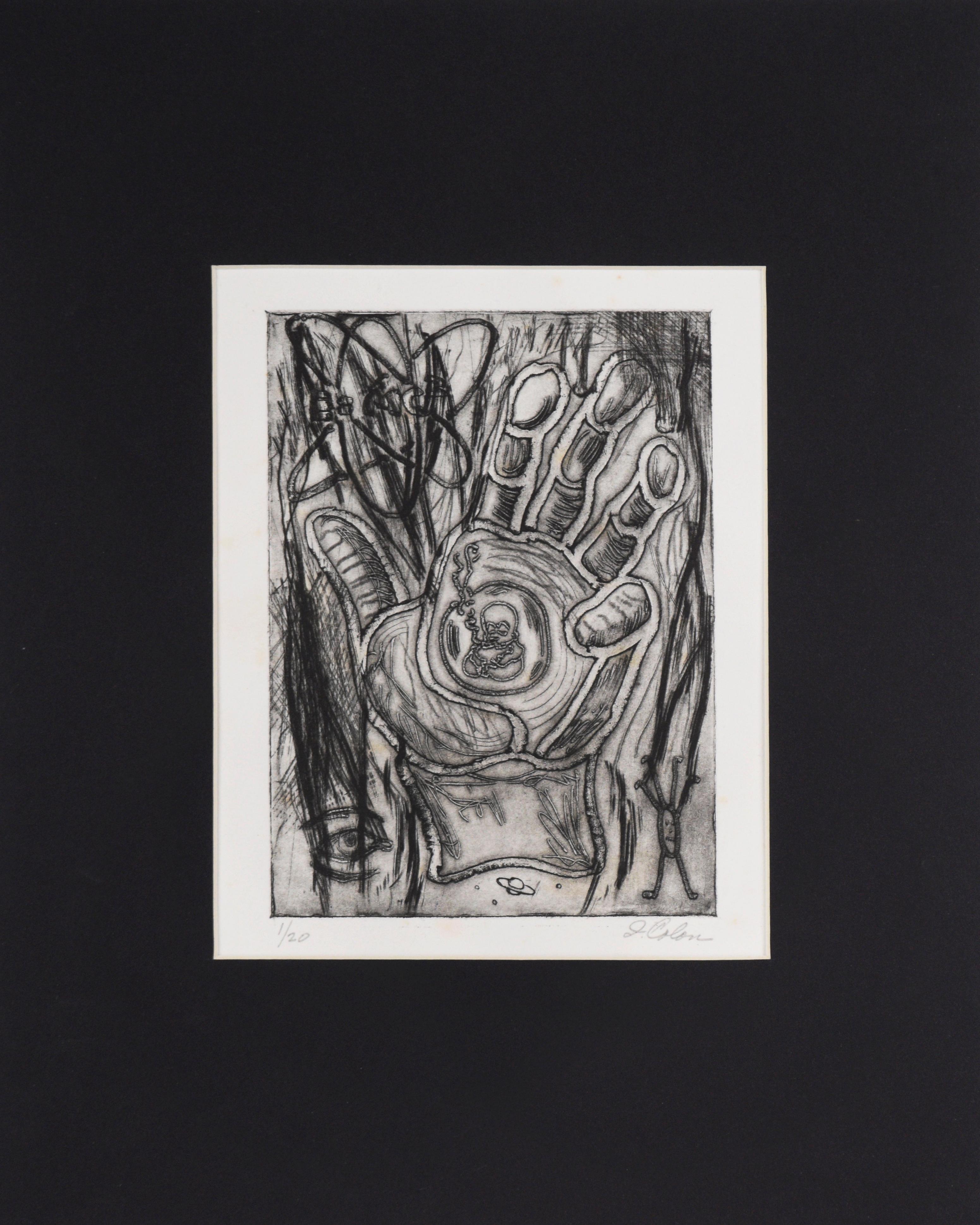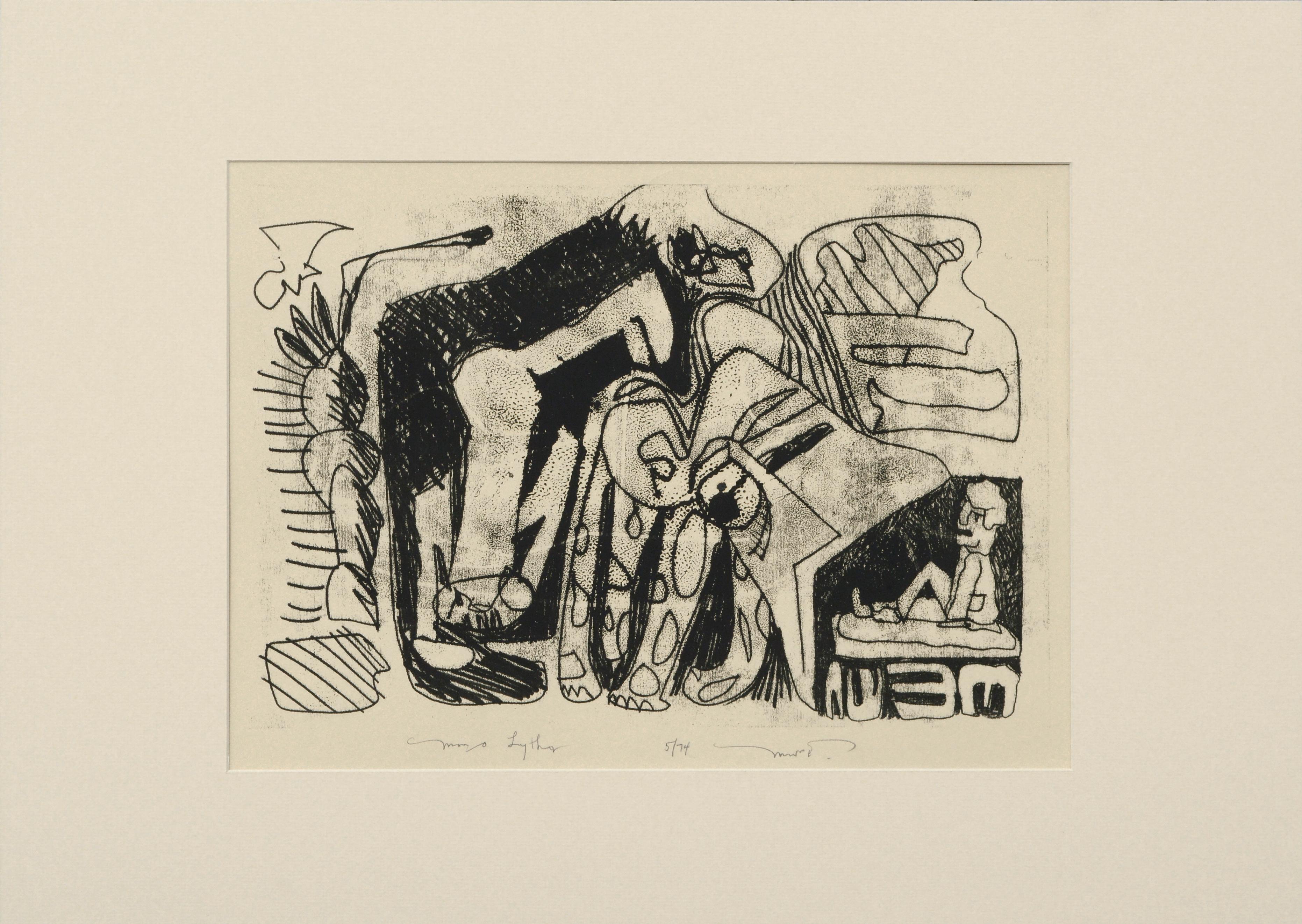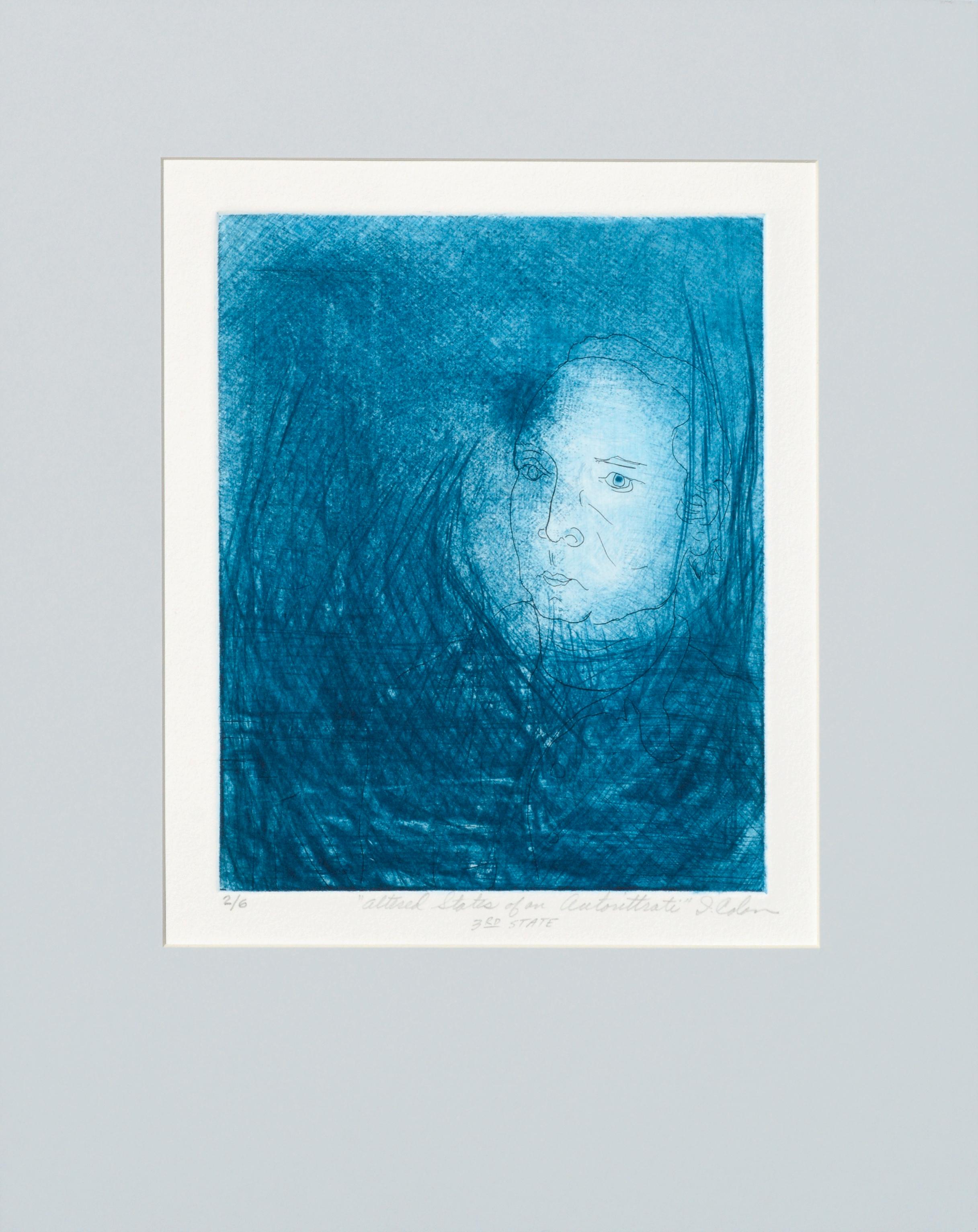Items Similar to 1960s Abstract American Modernist Pencil Signed Colored Lithograph Print
Want more images or videos?
Request additional images or videos from the seller
1 of 15
Lewis Tilley1960s Abstract American Modernist Pencil Signed Colored Lithograph Print1966
1966
About the Item
1966 American Modernist abstract color lithograph by Lewis Lee Tilley (1921-2005). The print is singed and editioned/numbered 4 of 5 prints by the artist. Presented in a custom frame, outer dimensions measure 29 x 23 inches. Image size is 12 ½ x 10 ½ inches.
Piece is clean and in very good condition - please contact us for a detailed condition report.
Provenance: Fremont Center for the Arts, Canon City, Colorado (deaccessioned)
Expedited and international shipping is available - please contact us for a quote.
About the Artist:
Excerpted from Colorado Springs Gazette Telegraph newspaper article of September 1949
Painter, Editor, Radio Director, and Actor.
Born in Parrott, GA. in 1921, he early showed that he was not going to grow up to be a traditional southern gentleman. After a year at Emory University, a course at the High Museum of Art in Atlanta, and graduation with a degree of Bachelor of Fine Arts from the University of Georgia, he tried his talents as Art Editor of the Atlanta Journal magazine section, and then took a whirl in radio as Director of a station in McComb, MS.
As a protege of Boardman Robinson he found his way to the Colorado Springs Fine Arts Center School in Colorado Springs, CO., where he graduated all over again and became interested and became an instructor.
Tilly has a wide background as artist, author, designer-illustrator, and as producer-director for Alexander Film Co., makers of motion picture commercials and documentaries. He also received his MFA degree from the University of Guanajuato, Instituto de Allende, Mexico.
Tilly authored "Booklet Design and Production" for The Nigerian Teacher magazine, and "The History of Writing and Printing" for the Northern Nigerian Ministry of Education. He has had articles published in American Home, Architectural Forum, Leica Photography, US Camera and in numerous other magazines.
Submitted by:
Katherine Tozier
- Creator:Lewis Tilley (1921 - 2005)
- Creation Year:1966
- Dimensions:Height: 22.5 in (57.15 cm)Width: 20.25 in (51.44 cm)Depth: 0.5 in (1.27 cm)
- Medium:
- Movement & Style:
- Period:
- Framing:Frame IncludedFraming Options Available
- Condition:
- Gallery Location:Denver, CO
- Reference Number:
About the Seller
5.0
Platinum Seller
These expertly vetted sellers are 1stDibs' most experienced sellers and are rated highest by our customers.
Established in 1979
1stDibs seller since 2013
265 sales on 1stDibs
Typical response time: 3 hours
- ShippingRetrieving quote...Ships From: Denver, CO
- Return PolicyA return for this item may be initiated within 7 days of delivery.
More From This SellerView All
- Gothic Towers, 1950s Abstract Modern Silkscreen Print, Orange, Brown, GreenBy Edward ChavezLocated in Denver, COSerigraph on paper titled "Gothic Towers" by Edward (Eduardo) Arcenio Chavez (1917-1995) from circa 1955 of an abstract tower structure with orange, brown, greens and white. Presented framed, outer dimensions measure 25 ¼ x 17 ½ x 1 ½ inches. Image sight size 18 ½ x 11 ¼ inches. Print is clean and in very good vintage condition - please contact us for a detailed condition report. Expedited and international shipping is available - please contact us for a quote. About the Artist: Born in Wagonmound, New Mexico, Eduardo Chavez...Category
1950s Abstract Abstract Prints
MaterialsPaper, Screen
- Mid Century Modern Woodblock Print, Red Black Group of Figures, American ModernBy Margo HoffLocated in Denver, COWoodblock on colored paper by Margo Hoff (1910-2008) titled 'Observers' of a black and red abstract scene with seventeen figures whose arms are in various positions, looking out at t...Category
20th Century American Modern Abstract Prints
MaterialsPaper, Woodcut
- Indian with Bow in Fox Costume, 1930s Modernist Print by Hilaire HilerBy Hilaire HilerLocated in Denver, CO'Indian with Bow in Fox Costume' is a vintage 1934 WPA era modernist color serigraph/silkscreen print by New Mexico artist, Hilaire Hiler (1898-1966) depicting a Native American figure with stylized feather headdress and Bow in black and red with white. Pencil signed by the artist in the lower right margin. Presented in a custom frame with all archival materials and UV protectant glass, outer dimensions measure 17 ½ x 15 x 1 ½ inches. Image size is 10 x 7 inches (sight). Expedited and International shipping is available - please contact us for a quote. About the Artist: Hilaire Hiler was born in St. Paul, Minnesota, and was raised in Providence, Rhode Island. Hiler took art classes as a child at the Rhode Island School of Design. When he was older, Hiler studied at the Pennsylvania Academy of the Fine Arts, the Pennsylvania School of Industrial Art, Wharton School of Finance and Commerce, and William Server's studio. He also studied at the University of Pennsylvania, the University of Denver, Golden State University, and National College in Ontario, Canada. He continued on to France, studying at the University of Paris in 1919. Hiler lived in Paris from 1919-1934, supporting himself as a jazz musician and a piano player for The Jockey Club. Hiler moved back to America in 1934, settling in San Francisco. He was commissioned by the Works Progress Administration (WPA) to paint murals in the Aquatic Park...Category
1930s American Modern Abstract Prints
MaterialsScreen
- Group of Five 1980s Abstract Lithographs Individually Titled, Red & BlackBy Dale ChismanLocated in Denver, COGroup of five abstract lithographs signed and individually titled by artist Dale Chisman from 1987. Titles are: At Midnight, I Breathed A Gentle Fragrance, If You Love for Beauty's S...Category
1980s Abstract Abstract Prints
MaterialsLithograph, Archival Paper
- 1940s Vertical American Modern Mining Town Landscape Lithograph, Mountain SceneBy Otis DozierLocated in Denver, COLithograph titled "Mining Town" by Otis Dozier (1904-1987) from 1940. Modernist scene of a mountain mining town with several buildings at the base of the mountain. Presented in a custom black frame, outer dimensions measure 25 ½ x 18 ⅜ x ¼ inches. Image sight size is 16 ¼ x 9 ½ inches. Print is clean and in very good condition - please contact us for a detailed condition report. Provenance: Private Collection, Denver, Colorado Expedited and international shipping is available - please contact us for a quote. About the Artist: Born in Forney, Texas, Otis Marion Dozier was raised on a farm in Mesquite, Texas. Dozier was a muralist, potter, lithographer, sculptor, and painter. Dozier was a member of a group of Texas regionalist artists known as the "Dallas Nine." His surroundings in Texas became the focus of much of his art. Dozier’s first artistic training took place in the early 1920’s when his family moved to Dallas. He studied under Vivian Aunspaugh, Cora Edge, and Frank Reaugh...Category
1940s Abstract Abstract Prints
MaterialsPaper, Lithograph
- Convolution, 1940s Modern Black White Abstract Lithograph of Kinetic MovementBy Herbert BayerLocated in Denver, CO"Convolution" is a lithograph on paper by Herbert Bayer (1900-1985) from 1948 of an abstract kinetic movement shape. Presented framed in all archival materials, outer dimensions measure 23 x 26 ¾ x 1 ¼ inches. Image sight size is 17 x 22 inches. Print is clean and in very good condition - please contact us for a detailed condition report. Expedited and international shipping is available - please contact us for a quote. About the Artist: Herbert Bayer Born 1900, Haag am Hausruck, Ausstria Died 1985, Montecito, California Herbert Bayer enjoyed a versatile sixty-year career spanning Europe and America that included abstract and surrealist painting, sculpture, environmental art, industrial design, architecture, murals, graphic design, lithography, photography and tapestry. He was one of the few “total artists” of the twentieth century, producing works that “expressed the needs of an industrial age as well as mirroring the advanced tendencies of the avant-garde.” One of four children of a tax revenue officer growing up in a village in the Austrian Salzkammergut Lake region, Bayer developed a love of nature and a life-long attachment to the mountains. A devotee of the Vienna Secession and the Vienna Workshops (Wiener Werkstätte) whose style influenced Bauhaus craftsmen in the 1920s, his dream of studying at the Academy of Art in Vienna was dashed at age seventeen by his father’s premature death. In 1919 Bayer began an apprenticeship with architect and designer, Georg Schmidthamer, where he produced his first typographic works. Later that same year he moved to Darmstadt, Germany, to work at the Mathildenhöhe Artists’ Colony with architect Emanuel Josef Margold of the Viennese School. As his working apprentice, Bayer first learned about the design of packages – something entirely new at the time – as well as the design of interiors and graphics of a decorative expressionist style, all of which later figured in his professional career. While at Darmstadt, he came across Wassily Kandinsky’s book, Concerning the Spiritual in Art, and learned of the new art school, the Weimar Bauhaus, in which he enrolled in 1921. He initially attended Johannes Itten’s preliminary course, followed by Wassily Kandinsky’s workshop on mural painting. Bayer later recalled, “The early years at the Bauhaus in Weimar became the formative experience of my subsequent work.” Following graduation in 1925, he was appointed head of the newly-created workshop for print and advertising at the Dessau Bauhaus that also produced the school’s own print works. During this time he designed the “Universal” typeface emphasizing legibility by removing the ornaments from letterforms (serifs). Three years later he left the Bauhaus to focus more on his own artwork, moving to Berlin where he worked as a graphic designer in advertising and as an artistic director of the Dorland Studio advertising agency. (Forty years later he designed a vast traveling exhibition, catalog and poster -- 50 Jahre Bauhaus -- shown in Germany, South America, Japan, Canada and the United States.) In pre-World War II Berlin he also pursued the design of exhibitions, painting, photography and photomontage, and was art director of Vogue magazine in Paris. On account of his previous association with the Bauhaus, the German Nazis removed his paintings from German museums and included him among the artists in a large exhibition entitled Degenerate Art (Entartete Kunst) that toured German and Austrian museums in 1937. His inclusion in that exhibition and the worsening political conditions in Nazi Germany prompted him to travel to New York that year with Marcel Breuer, meeting with former Bauhaus colleagues, Walter Gropius and László Moholy-Nagy to explore the possibilities of employment after immigration to the United States. In 1938 Bayer permanently relocated to the United States, settling in New York where he had a long and distinguished career in practically every aspect of the graphic arts, working for drug companies, magazines, department stores, and industrial corporations. In 1938 he arranged the exhibition, “Bauhaus 1919-1928” at the Museum of Modern Art, followed later by “Road to Victory” (1942, directed by Edward Steichen), “Airways to Peace” (1943) and “Art in Progress” (1944). Bayer’s designs for “Modern Art in Advertising” (1945), an exhibition of the Container Corporation of America (CAA) at the Art Institute of Chicago, earned him the support and friendship of Walter Paepcke, the corporation’s president and chairman of the board. Paepcke, whose embrace of modern currents and design changed the look of American advertising and industry, hired him to move to Aspen, Colorado, in 1946 as a design consultant transforming the moribund mountain town into a ski resort and a cultural center. Over the next twenty-eight years he became an influential catalyst in the community as a painter, graphic designer, architect and landscape designer, also serving as a design consultant for the Aspen Cultural Center. In the summer of 1949 Bayer promoted through poster design and other design work Paepcke’s Goethe Bicentennial Convocation attended by 2,000 visitors to Aspen and highlighted by the participation of Albert Schweitzer, Arthur Rubenstein, Jose Ortega y Gasset and Thornton Wilder. The celebration, held in a tent designed by Finnish architect Eero Saarinen, led to the establishment that same year of the world-famous Aspen Music Festival and School regarded as one of the top classical music venues in the United States, and the Aspen Institute for Humanistic Studies in (now the Aspen Institute), promoting in Paepcke’s words “the cross fertilization of men’s minds.” In 1946 Bayer completed his first architecture design project in Aspen, the Sundeck Ski Restaurant, at an elevation of 11,300 feet on Ajax Mountain. Three years later he built his first studio on Red Mountain, followed by a home which he sold in 1953 to Robert O. Anderson, founder of the Atlantic Richfield Company who became very active in the Aspen Institute. Bayer later designed Anderson’s terrace home in Aspen (1962) and a private chapel for the Anderson family in Valley Hondo, New Mexico (1963). Transplanting German Bauhaus design to the Colorado Rockies, Bayer created along with associate architect, Fredric Benedict, a series of buildings for the modern Aspen Institute complex: Koch Seminar Building (1952), Aspen Meadows guest chalets and Center Building (both 1954), Health Center and Aspen Meadows Restaurant (Copper Kettle, both 1955). For the grounds of the Aspen Institute in 1955 Bayer executed the Marble Garden and conceived the Grass Mound, the first recorded “earthwork” environment In 1973-74 he completed Anderson Park for the Institute, a continuation of his fascination with environmental earth art. In 1961 he designed the Walter Paepcke Auditorium and Memorial Building, completing three years later his most ambitious and original design project – the Musical Festival Tent for the Music Associates of Aspen. (In 2000 the tent was replaced with a design by Harry Teague.) One of Bayer’s ambitious plans from the 1950s, unrealized due to Paepcke’s death in 1960, was an architectural village on the outskirts of the Aspen Institute, featuring seventeen of the world’s most notable architects – Walter Gropius, Marcel Breuer, I.M. Pei, Minoru Yamasaki, Edward Durrell Stone and Phillip Johnson – who accepted his offer to design and build houses. Concurrent with Bayer’s design and consultant work while based in Aspen for almost thirty years, he continued painting, printmaking, and mural work. Shortly after relocating to Colorado, he further developed his “Mountains and Convolutions” series begun in Vermont in 1944, exploring nature’s fury and repose. Seeing mountains as “simplified forms reduced to sculptural surface in motion,” he executed in 1948 a series of seven two-color lithographs (edition of 90) for the Colorado Springs Fine Arts Center. Colorado’s multi-planal typography similarly inspired Verdure, a large mural commissioned by Walter Gropius for the Harkness Commons Building at Harvard University (1950), and a large exterior sgraffito mural for the Koch Seminar Building at the Aspen Institute (1953). Having exhausted by that time the subject matter of “Mountains and Convulsions,” Bayer returned to geometric abstractions which he pursued over the next three decades. In 1954 he started the “Linear Structure” series containing a richly-colored balance format with bands of sticks of continuously modulated colors. That same year he did a small group of paintings, “Forces of Time,” expressionist abstractions exploring the temporal dimension of nature’s seasonal molting. He also debuted a “Moon and Structure” series in which constructed, architectural form served as the underpinning for the elaboration of color variations and transformations. Geometric abstraction likewise appeared his free-standing metal sculpture, Kaleidoscreen (1957), a large experimental project for ALCOA (Aluminum Corporation of America) installed as an outdoor space divider on the Aspen Meadows in the Aspen Institute complex. Composed of seven prefabricated, multi-colored and textured panels, they could be turned ninety degrees to intersect and form a continuous plane in which the panels recomposed like pieces of a jigsaw puzzle. He similarly used prefabricated elements for Articulated Wall, a very tall free-standing sculpture commissioned for the Olympic Games in Mexico...Category
1940s Abstract Abstract Prints
MaterialsPaper, Lithograph
You May Also Like
- LET'S MAKE THE WHOLE DIMILITARIZED ZONE IN A GRAND PARK FOR ALL KOREAN......Located in Aventura, FLLithograph in colors on paper. Hand signed and numbered by the artist. HC edition. Artwork is in excellent condition. Certificate of Authenticity included. All reasonable offer...Category
1980s Abstract Abstract Prints
MaterialsPaper, Lithograph
- Time And Space - Black and White Lithograph On PaperBy I. ColonLocated in Soquel, CAStriking abstract expressionist lithograph by I. Colon (20th Century). An open hand with a baby in the palm is the focal point with objects, including a spaceship, an eye and doodles...Category
Late 20th Century Abstract Expressionist Figurative Prints
MaterialsPaper, Ink, Lithograph
- HAARLEMBy Johnny FriedlaenderLocated in Aventura, FLSigned and numbered by the artist. Artwork was previously framed and shows signs of aging in the margins from light exposure. Certificate of authenticity included. Edition of 350. ...Category
1960s Abstract Abstract Prints
MaterialsLithograph, Paper
- Abstract Lithograph with Animals and FiguresBy Michael William EgglestonLocated in Soquel, CAAbstract figurative lithograph with a lively jumble of abstracted animal and figurative forms by Michael William Eggleston (American, 20th Century). Titled (illegible), numbered ("5/...Category
Late 20th Century Abstract Expressionist Abstract Prints
MaterialsPaper, Ink, Lithograph
- "Altered States of an Autorittrati" 3rd State, Modernist Blue Self-PortraitBy I. ColonLocated in Soquel, CABold modernist self portrait in blue, a lithograph by California artist I. Colon (20th Century). Numbered, titled, and signed along the bottom edge ("2/6 "Altered States of an Aut...Category
Late 20th Century Abstract Impressionist Figurative Prints
MaterialsPaper, Ink, Lithograph
- "Altered States of an Autorittrati", Skeleton Limited Edition LithographBy I. ColonLocated in Soquel, CAStriking figurative abstract lithograph with skeleton by California artist I. Colon (20th Century). Numbered, titled, and signed along the bottom edge ("E.V. IV/X "Altered States ...Category
Late 20th Century Abstract Impressionist Figurative Prints
MaterialsPaper, Ink, Lithograph
Recently Viewed
View AllMore Ways To Browse
Lithograph 1960s
Modernist Print
American Vintage Sign Co
Lithograph Prints Of Architecture
American Modernist Prints
Modernist Lithograph
Vintage Lee Prints
Pencil Colored Lithograph
Print Architecture 1960
Modernist Print Signed Numbered
Modernist Abstract Print Signed
Vintage All Radio
Retro Radio Designs
1960 Vintage Radio
Mexican Modernist Art Print
Architecture Prints Georgian
Georgian Gentleman
Radio Station Vintage





